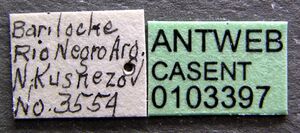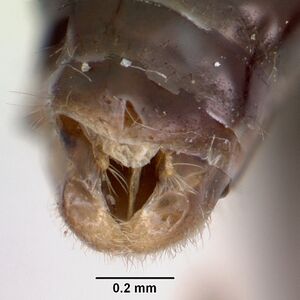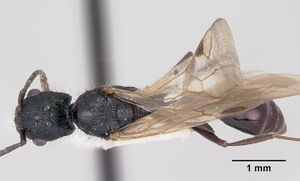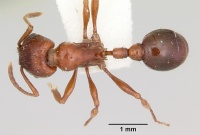Patagonomyrmex odoratus
| Patagonomyrmex odoratus | |
|---|---|

| |
| Scientific classification | |
| Kingdom: | Animalia |
| Phylum: | Arthropoda |
| Class: | Insecta |
| Order: | Hymenoptera |
| Family: | Formicidae |
| Subfamily: | Myrmicinae |
| Tribe: | Pogonomyrmecini |
| Genus: | Patagonomyrmex |
| Species: | P. odoratus |
| Binomial name | |
| Patagonomyrmex odoratus Kusnezov, 1949 | |
Observations made by Kusnezov (1949, 1953, 1960) form the bulk of what is known about the biology of ants in this genus. Most of his observations were for Patagonomyrmex odoratus, but the biology of these three species appears similar, and thus all three species are discussed together. Nests are variable, ranging from an entrance lacking a tumulus to one that is 10–12 cm in diameter. Typically, nests are located in open areas or under stones or other objects. Workers of all three species are diurnal, slow-moving, solitary foragers that are timid and non-aggressive. Little information is available on food items collected, though Kusnezov (1960) indicated that they were granivores. Colonies of P. odoratus probably contain fewer than 300–400 workers (Kusnezov, 1949); colony size for Patagonomyrmex angustus and Patagonomyrmex laevigatus appears to be similar (Kusnezov, 1949; 1960; pers. obs.).
Identification
Johnson and Moreau (2016) - Worker This species is uniquely characterized by the following combination of features: (1) longitudinal rugae on cephalic dorsum rarely continue to posterior margin, (2) interrugae on cephalic dorsum and dorsum of promesonotum mostly smooth and shining, (3) posterior surface of petiolar node smooth and shining, (4) inferior propodeal spines triangular, length and width similar, notably shorter than superior spines, and (5) head and mesosoma mostly concolorous amber-orange to brownish-orange, gaster usually darker orangish-black.
Queen This caste is diagnosed by: (1) caste-specific morphology of the mesosoma related to wing-bearing and presence of ocelli on head, (2) mesoscutum and mesoscutellum smooth and shiny, (3) inferior propodeal spines triangular, much shorter than superior propodeal spines, and (4) body orangish-brown, gaster slightly darker.
Male This caste is diagnosed by: (1) mesopleura, metapleura, pronotal sides and/or dorsum of propodeum with weak to strong rugae, (2) no hairs on ventral surface of head or those protruding from mandibles approach MOD, and (3) in profile, juncture between cephalic dorsum and posterior declivity (near posterior margin of ocelli) strongly angulate; posterior declivity strongly concave.
Patagonomyrmex odoratus co-occurs with Patagonomyrmex angustus and Patagonomyrmex laevigatus. Patagonomyrmex odoratus can be distinguished from Pa. angustus based on the following characters: (1) dorsum of promesonotum and posterior surface of petiolar node smooth and shining (both structures moderately granulate in Pa. angustus), and (2) inferior propodeal spines triangular, shorter than superior propodeal spines (inferior propodeal spines elongate with length similar to that of superior propodeal spines in Pa. angustus). In his key, Kusnezov (1951) separated Pa. odoratus from Pa. laevigatus based on the orangish-brown body with a slightly darker gaster in Pa. odoratus versus mostly concolorous blackish to black body in Pa. laevigatus. Kusnezov (1949, 1951) also indicated that the longitudinal rugae on the cephalic dorsum were less coarse in Pa. odoratus than in Pa. laevigatus, but I could not discern this difference. He also indicated the angle between the peduncle of the petiole and the anterior surface of the petiolar node was more rounded in Pa. laevigatus, and more angulate in Pa. odoratus. This character appeared to be very subtle and inconsistent, and thus was not a useful diagnostic trait. We did not find any morphological measurements that could be used to separate Pa. odoratus from its two congeners.
Keys including this Species
Distribution
Latitudinal Distribution Pattern
Latitudinal Range: -32.36666667° to -41.10055556°.
| North Temperate |
North Subtropical |
Tropical | South Subtropical |
South Temperate |
- Source: AntMaps
Distribution based on Regional Taxon Lists
Neotropical Region: Argentina (type locality), Chile.
Distribution based on AntMaps
Distribution based on AntWeb specimens
Check data from AntWeb
Countries Occupied
| Number of countries occupied by this species based on AntWiki Regional Taxon Lists. In general, fewer countries occupied indicates a narrower range, while more countries indicates a more widespread species. |

|
Estimated Abundance
| Relative abundance based on number of AntMaps records per species (this species within the purple bar). Fewer records (to the left) indicates a less abundant/encountered species while more records (to the right) indicates more abundant/encountered species. |

|
Biology
Alate queens and males are known for all three species; collection dates for sexuals range from October 9 to May 27 for Patagonomyrmex angustus (October 9–22 in Chile; November 16 to May 27 in Argentina), January 25 to February 17 for Patagonomyrmex laevigatus, and January 15 to February 18 for Patagonomyrmex odoratus (Kusnezov, 1949; R.A. Johnson, unpub. data). Number of sexuals in nests ranged from 1–18 alate queens and 1–7 males in Pa. angustus, 4–5 alate queens and 5– 19 males in Pa. laevigatus, and 1–54 alate queens and 1–19 males in Pa. odoratus (Kusnezov, 1949). Mating flights are unknown for all three species, but the above dates suggest that flights occur during the austral summer, probably from late January through March or later. The trigger for mating flights is unknown. Nest excavations indicate that colonies of all three species typically contain 1–2 reproductive (dealate) queens (Pa. odoratus: 1 queen [n = 1], 2 queens [1]; Pa. laevigatus: 1 queen [1]; Pa. angustus: 1 queen [3], 2 queens [1]) (see Kusnezov, 1949; R.A. Johnson, unpub. data).
All three species of Patagonomyrmex are restricted to cool, relatively humid, short growing-season climates in southern Argentina and southern to southcentral Chile, typically in habitats dominated by Nothofagus or Austrocedrus (=Libocedrus in Kusnezov, 1949). Patagonomyrmex laevigatus has the most restrictive distribution as it is only known from shady areas in well-developed mesophilic coihue (Nothofagus dombeyi) forests, i.e., it is absent from arid and semi-arid habitats including Austrocedrus forests (Kusnezov, 1949). Patagonomyrmex angustus and Pa. odoratus also have relatively localized distributions in Argentina, but both species have broader distributions in Chile; Pa. odoratus occurs north to near Santiago (Solervicens et al., 1991; specimens not examined), and Pa. angustus is common to as far north as the Valparaíso Region. Both Pa. odoratus and Pa. angustus occur in several biogeographic zones-bioclimatic regions in Chile, whereas Pa. laevigatus has a very restricted distribution. Using the ecoregions defined by Olson et al. (2001), Pa. angustus occurs in the Validivian Temperate Forest and Chilean Matorral ecoregions, with one record from the western edge of the Patagonian Steppe; both Pa. laevigatus and Pa. odoratus are restricted to the Valdivian Temperate Forest ecoregion.
All three species of Patagonomyrmex can be sympatric, but each species more typically occurs in different microhabitats. Patagonomyrmex odoratus sometimes co-occurs with Pa. laevigatus in shaded Nothofagus forests, but it is more common in exposed, slightly drier microsites such as open areas with low densities of Chilean cedar (Austrocedrus chilensis) (Kusnezov, 1949). Patagonomyrmex angustus occurs over the widest range of microhabitats, including the Araucaria, Nothofagus, and Austrocedrus zones, largely in more exposed, drier microhabitats than those used by both Pa. laevigatus and Pa. odoratus. Patagonomyrmex laevigatus occurs at elevations from ~220->1000 m in Chile and 560–950 m in Argentina, Pa. odoratus ranges from 540–1700 m in Argentina and from ~1000–1940 m in Chile, and Pa. angustus ranges from 390–1005 m in Argentina, and from 0– 2000 m in Chile.
Castes
Queen
Images from AntWeb
   
| |
| Queen (alate/dealate). Specimen code casent0103396. Photographer April Nobile, uploaded by California Academy of Sciences. | Owned by USNM, Washington, DC, USA. |
   
| |
| Queen (alate/dealate). Specimen code casent0103397. Photographer April Nobile, uploaded by California Academy of Sciences. | Owned by USNM, Washington, DC, USA. |
Male
Images from AntWeb
     
| |
| Male (alate). Specimen code casent0103405. Photographer April Nobile, uploaded by California Academy of Sciences. | Owned by USNM, Washington, DC, USA. |
Phylogeny
| Pogonomyrmecini |
| |||||||||||||||||||||
Based on Johnson & Moreau, 2016.
Nomenclature
The following information is derived from Barry Bolton's Online Catalogue of the Ants of the World.
- odoratus. Pogonomyrmex (Ephebomyrmex) odoratus Kusnezov, 1949c: 302, figs. 1, 2 (w.q.m.) ARGENTINA.
- Combination in Ephebomyrmex: Kusnezov, 1960b: 354
- Combination in Pogonomyrmex: Snelling & Hunt, 1976: 75.
- Combination in Patagonomyrmex: Johnson & Moreau, 2016: 22.
Unless otherwise noted the text for the remainder of this section is reported from the publication that includes the original description.
Description
Worker
Johnson and Moreau (2016) - Lecotytpe (n = 4 + 9 paralectotypes). HL 1.27 (1.00–1.25); HW 1.11 (0.86–1.08); MOD 0.27 (0.24–0.29); OMD 0.18 (0.15–0.24); SL 0.91 (0.79–0.96); PNW 0.74 (0.62–0.73); HFL 1.12 (0.94–1.15); ML 1.52 (1.18–1.60); PW 0.30 (0.20–0.30); PPW 0.47 (0.39–0.45). Indices: SI 81.98 (79.63–96.00); CI 87.05 (82.46– 95.50); OI 24.32 (24.53–27.91); HFI 100.90 (91.43–110.64) (see also Kusnezov, 1949).
Longitudinal rugae on cephalic dorsum prominent, widely-spaced, weakly wavy, beginning on frontal lobes but rarely extending to posterior margin; posterior margin flat in full-face view. Wavy to irregular, often discontinuous rugae arc from mandibular margins to frontal lobes and traverse longitudinally above and below eyes, usually terminating before reaching vertex; lateral rugae weaker than those on cephalic dorsum. Interrugae on cephalic dorsum smooth and shining; vertex and posterior margin of head weakly granulate-punctate, weakly shining to smooth and shining. Dorum of clypeus with several moderately coarse, subparallel, longitudinal rugae. Mandible with six teeth; mandibular dorsum strongly rugose. MOD ranging from 0.21–0.25x HL. In profile, eyes situated anterior to middle of head, OMD = 0.57–0.89x MOD. In full-face view, eyes protruding slightly beyond lateral margins of head. Antennal scapes long (SI = 79.63–96.00), surpassing vertex by less than length of second funicular segment; scapes weakly to moderately granulate-punctate, often with faint striae, weakly shining; basal flange moderately well-developed with carinate margin.
Mesosomal profile strongly convex; dorsum of promesonotum smooth and shining; longitudinal rugae on mesospleura and metapleura wavy to irregular, interrugae weakly to moderately granulate-punctate, weakly shining. Promesonotal suture absent to weakly impressed on occasional individuals. Superior propodeal spines long, narrowing to blunt tip, length rarely exceeding 0.6–0.7x the distance between their bases; inferior propodeal spines moderately well-developed, triangular, acuminate to bluntly tipped, length and width similar, distinctly shorter than superior spines. Propodeal spiracles weakly ovate to circular facing posterad. Legs weakly granulate to smooth, weakly shining to shining.
Peduncle of petiole about as long as petiolar node, anteroventral margin of peduncle of petiole with a small, acuminate spine. In profile, posterior surface of petiolar node weakly convex; petiolar node asymmetrical with anterior surface shorter than posterior surface, apex rounded to bluntly angulate. In dorsal view, petiolar node longer than wide, sides subparallel, narrowing to rounded to bluntly angulate anterior margin. Dorsum of postpetiole convex in profile; in dorsal view, widest near posterior margin, narrowing to anterior margin, maximum width and length similar; posterior surface and sides of petiolar node and dorsum and sides of postpetiole smooth and shining; first gastral tergum smooth and shining.
Erect, short to long, copperish-brown hairs abundant on head, one to few approach to slightly exceed MOD. Moderately abundant subdecumbent to decumbent hairs on antennal scapes; abundant decumbent to appressed hairs on funicular segments. Legs with moderately abundant subdecumbent to decumbent setae. Mesosoma with moderately dense, medium to long, erect setae, longest approaching MOD; petiolar node, postpetiole, gastral terga with moderately dense erect setae, mostly similar in length, longest notably shorter than MOD. Body other than gaster mostly concolorous amber-orange to brownish-red, medial portion of cephalic dorsum usually slightly darker than rest of head; gaster dark orangish-black to brownish-black.
Queen
Johnson and Moreau (2016) - (n = 9 + 3 paralectotypes). HL 1.21–1.26; HW 1.05–1.12; MOD 0.30–0.33; OMD 0.17– 0.24; SL 0.83–0.97; PNW 0.85–0.93; HFL 1.03–1.14; ML 1.52–1.77; PW 0.26–0.33; PPW 0.49–0.54. Indices: SI 79.05–89.81; CI 83.33–92.56; OI 27.52–30.28; HFI 96.26–106.67 (see also Kusnezov, 1949).
Male
Johnson and Moreau (2016) - (n = 2 + 1 paralectotype). HL 1.08–1.22; HW 0.90–1.01; MOD 0.41–0.45; OMD 0.16–0.19; SL 0.28–0.33; HFL 0.98–1.17; ML 1.71–1.75; PW 0.23–0.27; PPW 0.38–0.42. Indices: SI 29.17–36.67; CI 82.79– 85.71; OI 43.75–45.56; HFI 102.08–123.33 (see also Kusnezov, 1949).
Type Material
Johnson and Moreau (2016) - Syntypes examined: 6 workers, 3 alate queens Fundacion e Instituto Miguel Lillo , 11 workers, 7 alate queens Los Angeles County Museum of Natural History, 2 workers, 1 alate queen Museo de La Plata, Argentina, 12 workers, 4 alate queens, 2 males National Museum of Natural History, Argentina, Río Negro: Bariloche, Cerro Otto, #3554 (N. Kusnezov leg., 6 February 1949); #3553—same data as lectotype: 6 workers, 3 males [IMLA]. USNM worker here designated Lectotype [CASENT0914807].
In his description of this species, Kusnezov (1951) listed six localities at which Pa. odoratus had been collected, but he did not designate a type locality. In their treatment of the ants of Chile, Snelling & Hunt (1975) chose Hua Hum as the type locality because it was the first of six localities listed by Kusnezov (1949). Our designation of a lectotype supercedes this act, and the type locality is now Cerro Otto, Río Negro Province, Argentina.
Etymology
Johnson and Moreau (2016) - In his description, Kusnezov did not give information regarding the naming of this species. However, Kunezov (1960) indicated that the name was derived from the odor emitted by the species.
References
- Johnson, R.A., Moreau, C.S. 2016. A new ant genus from southern Argentina and southern Chile, Patagonomyrmex (Hymenoptera: Formicidae). Zootaxa 4139: 1–31 (DOI:10.11646/zootaxa.4139.1.1).
- Kusnezov, N. 1949c. Pogonomyrmex del grupo Ephebomyrmex en la fauna de la Patagonia (Hymenoptera, Formicidae). Acta Zool. Lilloana 8: 291-307 (page 302, worker, queen, male described)
- Kusnezov, N. 1960b [1959]. La fauna de hormigas en el oeste de la Patagonia y Tierra del Fuego. Acta Zool. Lilloana 17: 321-401 (page 354, Combination in Ephebomyrmex)
- Snelling, R. R.; Hunt, J. H. 1975. The ants of Chile (Hymenoptera: Formicidae). Rev. Chil. Entomol. 9: 63-129 (page 75, Combination in Pogonomyrmex)
References based on Global Ant Biodiversity Informatics
- Snelling R. R., and J. H. Hunt. 1975. The ants of Chile (Hymenoptera: Formicidae) Revista Chilena de Entomología 9: 63-129.

